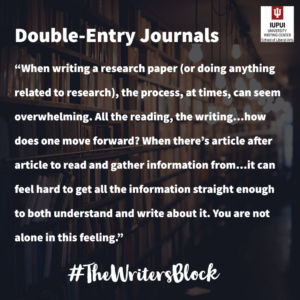Note-Taking in the Research Process: Double-Entry Journals
by Shannon Kucaj

When writing a research paper (or doing anything related to research), the process, at times, can seem overwhelming. All the reading, the writing…how does one move forward? When there’s article after article to read and gather information from…it can feel hard to get all the information straight enough to both understand and write about it. You are not alone in this feeling. One note-taking strategy that can help with this is called the Double-Entry Journal. This tool is meant to help you keep track of your sources and your notes, thoughts, and feelings on those particular sources—all in one place. This can help you have easy access to your notes when you are beginning to draft up your research paper or move forward in the research process. One way to frame a Double-Entry Journal is compiling four main parts within it: 1) citation of source, 2) summary of course, 3) notes from source, and 4) reaction to source (Brooks-Gillies).
 The first step is to cite the article in the preferred citation style as this will help you keep track of what source you are currently referencing and also help when citing the material in your papers or projects. For assistance with the citation process, the Purdue OWL is a wonderful resource that contains information on various citation styles (MLA, APA, and Chicago). This resource has specific sections to help you format and draft the citation in the correct method for that specific style (Brooks-Gillies). You could also check out your style of choice’s style manual which you can find versions of on IUPUI’s University Library IUCAT.
The first step is to cite the article in the preferred citation style as this will help you keep track of what source you are currently referencing and also help when citing the material in your papers or projects. For assistance with the citation process, the Purdue OWL is a wonderful resource that contains information on various citation styles (MLA, APA, and Chicago). This resource has specific sections to help you format and draft the citation in the correct method for that specific style (Brooks-Gillies). You could also check out your style of choice’s style manual which you can find versions of on IUPUI’s University Library IUCAT.
The second step of the process is to summarize the source after doing the reading. While reading your sources, you may choose to annotate them (such as circling/underlining/highlighting relevant information on the parts that stand out to you the most or writing brief notes in the margins for later reference). Then, while working on the Double-Entry Journal, you can reference these brief reactions in this summarizing section (Brooks-Gillies). Within this section, try to include the main points that the source is making in a way that you understand. Try to get as specific as possible here to help you when you start analyzing your sources all together. You could also include a few sentences at the end of your summary that indicate how you could use this source in your research project/paper and/or how it connects (or doesn’t connect) to the other sources you have (Brooks-Gillies).
The third step is to compile a section based specifically on your notes from the source. This is where you can input more specific information that supports the summary you detailed above (Brooks-Gillies). One way that I use this section is by copying and pasting direct quotes from the source (with its page number next to it) and then adding a comment in Word on that specific quote with my reactions and how I could potentially tie this into my overarching research project. Other ways that you can do this section is by: paraphrasing key ideas, summarizing key ideas, noting any key vocabulary/jargon, and discussing anything else that makes you respond personally (understandability, disagreement, emotional-response, relevancy) (Brooks-Gillies).
The final step of creating a Double-Entry Journal is to include further reactions on the material. Some helpful ways to think about how to react to a piece is by: including some freewriting where you discuss how the sources connect with one another or offer similar/different points on a related topic, discussing how you agree, disagree, or challenge the information present, noting the importance of such information, and writing about how the information you found connects to your personal experiences (Brooks-Gillies). Some ways you can do this is by commenting directly on the “notes from source” section or creating another section just for your responses. But, your ways of responding may be done in any way that you feel suits you the best!
Overall, a Double-Entry Journal is one useful way to help you during the research process, including citing, compiling notes for, and reacting to your sources. Think of this journal as a blueprint for your research project/paper. When you start on that next step of the research process, you can use this journal to help you center your thoughts, fine-tune your main topic, and reference relevant material too. When I am working on research projects/papers, I complete the Double-Entry Journal before I move forward in my process. Then, I will have this journal pulled up while I am writing to help me feel more secure in my ideas. And, you can format/write this journal in any way that best supports you and how you best take in information. It may take some trial and error, and that is completely okay. You’ve got this! If you find yourself needing additional support, our consultants would be happy to meet with you, as well.
Work Cited
Gillies-Brooks, Marilee. “Double Entry Journals.” ENG-W397 Writing Center Theory & Practice, 21 Oct. 2020, IUPUI, Class Handout.

